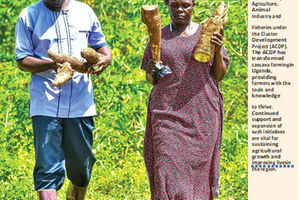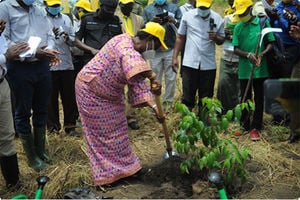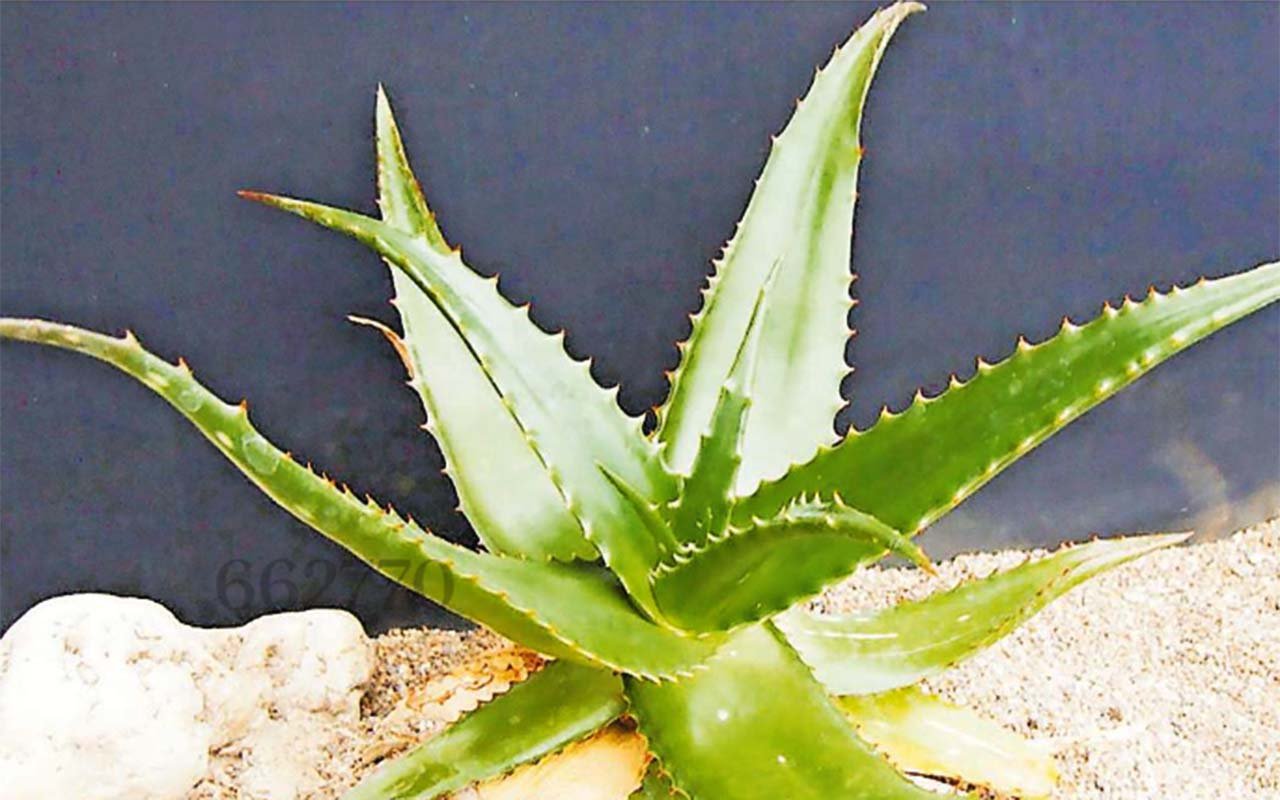
Stella Afoyocan in her cassava garden. She continues to grow the sweet new varieties and the bitter cassava. PHOTO/GEORGE KATONGOLE
For all her life, Stella Afoyocan of Kisomere Village, Ngwedo Parish, Buliisa District, has grown cassava. It has been her staple food, and she uses it to feed her nine dependents.
While her husband continues to fish on Lake Albert, she has grown her cassava gardens to more than 20 acres.
“Cassava is very popular here. It feeds everyone,” she says. Cassava is very popular among the Alur people, who are primarily found in Nebbi, Zombo, Arua, and Bunyoro. It’s a staple food traditionally prepared with greens and fish. Traditionally, cassava is fermented for four to six days to effect sufficient detoxification of the roots. But this was a big concern of food poisoning attributed to this practice. Cassava flour is obtained by pounding in mortars by children and women.
Because of the harsh climatic conditions in Buliisa, most of which is actually a pastoral area, they adapted to growing the bitter variety of cassava, which was resistant to pests, especially termites. The bitter cassava variety is also hardier but has a much higher cyanide content.
Recently, she has been introduced to the improved NAROCAS 1 variety, where she is a model farmer who supplies cuttings to other farmers in her area. Last season, she sold 260 bags of cuttings at a rate of Shs20,000 per bag.
“The improved variety is very good,” Afoyocan says. “We now don’t need to ferment the cassava because this variety can be eaten fresh yet it is marketable.”
New Variety
NAROCAS 1 is a high-yielding cassava variety developed by the National Agricultural Research Organisation (NARO) and released in 2011. It is known for its resistance to cassava mosaic disease, drought tolerance, early maturity of six months, high yields of 30 tonnes per hectare, and good taste.
Afoyocan is among the model farmers spreading the news about the new cassava variety. But she faces a battle against culture.
“Even though the flour from the NAROCAS variety is very clean, our people don’t like it. They like their traditional cassava. We need a mindset change,” Moses Openjumungu, also a model cassava farmer, says.
He explains that some farmers still process new varieties using traditional methods to meet the demand for brown cassava flour, which most consumers prefer.
The local cassava variety takes two years to be harvested. The yields are also low, about 800 kgs from an acre. The clash of cultures, however, reveals the deep-rooted cultural significance of cassava in many rural communities. From boiling and roasting to deep-frying and milling into flour, cassava is a versatile ingredient that forms the basis of numerous traditional dishes and local brews.
Cassava, a Climate-Smart Crop
Cassava, alongside sorghum, millet, groundnuts, and rice, are crops well-adapted to climate change due to their tolerance of drought.
Cassava is a valuable asset in the face of climate change. It is a climate-smart crop that is well-suited to the challenges posed by climate change. Its remarkable adaptability to various climatic conditions makes it a resilient and valuable food source.
One of the key advantages of cassava is its drought tolerance. It can thrive in arid and semi-arid regions, making it a reliable crop even in times of water scarcity. Its deep root system allows it to access water from lower soil layers, further enhancing its drought resilience.
Cassava can also withstand high temperatures, making it suitable for regions experiencing increased heat stress. It can also tolerate waterlogged soils for extended periods, making it resilient to flooding.
Modern cassava varieties have been developed to be resistant to pests and diseases, reducing crop losses and ensuring higher yields. Furthermore, cassava can be grown in marginal soils and can even improve soil fertility through its deep root system.
By incorporating climate-smart agricultural practices, such as improved seed varieties, efficient irrigation, and integrated pest management, farmers can further enhance the climate resilience of cassava production.
Even as researchers continue to develop climate-smart varieties that are resistant to drought, pests, and diseases, traditional crops can be grown to help mitigate the impacts of climate change on agriculture.
Although cassava is commonly processed in Uganda for home consumption, high-quality cassava flour (HQCF) production is becoming a channel to the commercialization of high-value cassava. HQCF can be used in commodities such as biscuits, paperboards, rural bakeries, and composite flour.
Improving the Quality of Cassava
With cassava continuing to play a crucial role in Uganda's food security, ensuring its sustainability is vital.
First of all, the cultivation of high-quality cassava is crucial. Selecting superior varieties that are resistant to diseases and pests, as well as high-yielding, is essential. Additionally, adopting good agricultural practices, such as proper planting techniques, fertilization, and pest management, can significantly improve crop quality.
Lydia Ajuna, a community-based facilitator on agronomy in Buliisa, explains: “If our farmers carefully select and plant suitable cassava varieties, they can enhance their livelihoods, improve food security, and contribute to sustainable agriculture.”
Following good agronomic cropping methods with proper post-harvest handling, farmers need to pay attention to efficient processing techniques, which are necessary to produce high-quality cassava flour. NARO is promoting the use of cassava chippers to improve cassava processing efficiency.
The cassava chippers are also essential for improving food safety. Uniformly sliced cassava dries more quickly, often in less than 24 hours, significantly reducing the risk of contamination. This rapid drying process also helps to preserve the nutritional value of the cassava.
Implementing rigorous quality control measures is essential to monitor moisture content, starch content, and microbial load. Establishing processing protocols can ensure consistent product quality. Proper packaging and storage can protect the flour from moisture, pests, and contamination.
To enhance the market value of cassava, farmers are advised to look for opportunities for value addition. Producing value-added products, such as cassava starch, cassava chips, and cassava-based snacks, can create new market opportunities. Promoting the consumption of cassava flour and cassava-based products through marketing and awareness campaigns can also stimulate demand.
“We always advise our farmers on the importance of value addition, emphasizing that cassava can be transformed into a variety of products, offering a sustainable path out of poverty,” says Ajuna.







